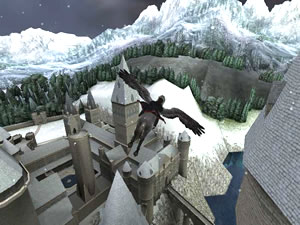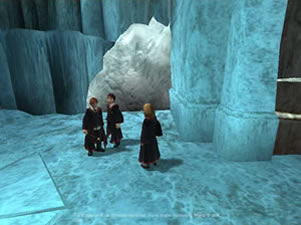Not much up its sleeve.
The Harry Potter franchise is something of a rarity, a fantasy book series that
successfully transitioned into an equally popular series of films. Hand it to
J.K. Rowling ” she did a great job ensuring that her initial vision didn’t turn
into, well, this.
Unfortunately for gamers, Ms. Rowling hasn’t done nearly as good a job keeping
watch over the video game versions of her stories, which so far have fallen short
of the technical excellence you might expect from such a blockbuster undertaking.
Some might attribute this to the much maligned Curse of the Movie License, but
I think it has more to do with the developers being unsure of its intended audience.
Children? Teens? Adults? The Harry Potter magic is that its appeal spans generations,
but so far, the games have been little more than glorified kid’s merchandising.
Much has been made, then, of the fact that Harry Potter
and the Prisoner of Azkaban is a darker, more mature film. Would the developers
respond with a darker, more mature game? Not so much, it turns out. Though Prisoner
of Azkaban is probably the best Harry
Potter game released thus far, it’s still primarily aimed at kids and
hardcore fans.
The plot follows the arc of the film, as Harry, Ron and Hermione attend their third year at Hogwart’s Academy. An insane wizard named Sirius Black has escaped from Azkaban prison and is rumored to be in search of Harry in order to enact revenge for some awful experience he had with Harry’s folks. Along the way, Harry and crew undergo more adventures and prepare for their final confrontation with Sirius.
But unlike many movie licensed games, Prisoner of Azkaban doesn’t directly mirror the events of the movie. Rather, you’ll undertake missions as the three young wizards that complement the events of the film or, at times, eschew it altogether.
The gameplay is very similar to the other Harry Potter games,
which in turn were similar to just about every other action/adventure platforming
game ever made. You run around Hogwart’s helping out classmates, collecting Bertie
Bott’s Every Flavor Beans, solving puzzles and fighting a variety of baddies
from the Potter universe.
New to the series is the ability to switch between the three wizards on the fly,
which is essential to the gameplay as each character has specialized spells
and talents that are required to solve certain puzzles. Hermione, for instance,
can use the Glacius spell to freeze water (necessary for several puzzles) and
can crawl into smaller spaces than the two boys, while Ron can use the Luminous
spell to light up magical glass orbs (also needed for several puzzles) and
can find secret passages. Harry is the only one able to jump (which he does
automatically when he gets close enough to a ledge), and, of course, is the
only one to learn the Patronus spell to ward off those pesky Dementors.
 Getting used to switching between the characters is key, because the game tends to repeat its puzzles. You’ll push blocks onto platforms and move giant glass lenses to aim light at keyholes over and over again. Though kids will enjoy the overall simplicity, more variety would have made it much more interesting for grown-up fans.
Getting used to switching between the characters is key, because the game tends to repeat its puzzles. You’ll push blocks onto platforms and move giant glass lenses to aim light at keyholes over and over again. Though kids will enjoy the overall simplicity, more variety would have made it much more interesting for grown-up fans.
All three versions of the game feature the same control scheme, allowing you
to equip two spells at a time. Combat is handled via a lock-on set up much
like what you’ll find in a Zelda game, which works well enough, though it’s a little sluggish and might frustrate younger gamers.
The game presents a sort of open-ended fa’ade ” you’ll complete a few objectives,
then be given the opportunity to proceed to the next day or wander about Hogwart’s.
Unfortunately, there’s
just not much purpose in exploring aside from getting more beans or talking to
NPCs, which admittedly may appeal to insatiable fans.
What won’t appeal to anyone are the nasty loading times as you switch between areas of the castle. This isn’t a problem when you’re outside roaming the grounds ” which is seamless and gives a nice, complete feel to the lay of the land ” but for some reason the game needs to load almost every time you open a door, even if the next room is small and looks like the one you were just in. It makes exploring more tedious than exciting.
Part of the problem is the fact that the missions have little to do with the more exciting plot of the film. You’ll spend a lot of time collecting ingredients for a potion or completing puzzles to gain a new spell, but most of the actual film story is handled by way of disjointed cut-scenes. Forget playing Quidditch ” that whole sequence of Harry getting chased by the Dementors takes place as non-interactive FMV. This makes the missions feel like time-killers in between plot twists.
 Harry Potter and the Prisoner of Azkaban does a decent job fleshing
Harry Potter and the Prisoner of Azkaban does a decent job fleshing
out Hogwart’s with occupants, but by and large the graphics on all three systems
are unimpressive. While the characters look right, the textures are flat and
the animations are stiff. It just doesn’t look like much of a next-generation
game.
Though the real actors didn’t lend their voices, the imitations are occasionally good (such as Hagrid’s Robbie Coltrane stand-in) and occasionally bad (Snape sounds nothing like Alan Rickman). The score is as rousing as the film’s and genuinely lends an epic, cinematic air to the game.
The Gamecube and Xbox versions of Prisoner of Azkaban feature
a few mini-games that can be played as bonus activities, but they’re pretty weak, especially
when compared to the PS2’s six EyeToy games. Swatting at frogs
and chasing after the golden snitch
is a nice touch for fans and offers something extra once you beat the
main game in about 10 hours.
Harry Potter and the Prisoner of Azkaban lets fans romp through
a digital version of the film and offers some decent gameplay along the way,
but it doesn’t
do much else. Provided that’s all you expect from a licensed game, you won’t
be entirely disappointed.
-
Interesting character switching
-
Can wander around Hogwartí¢â‚¬â„¢s
-
EyeToy support
-
Mediocre graphics
-
Annoying load times
-
Repetitive puzzles







